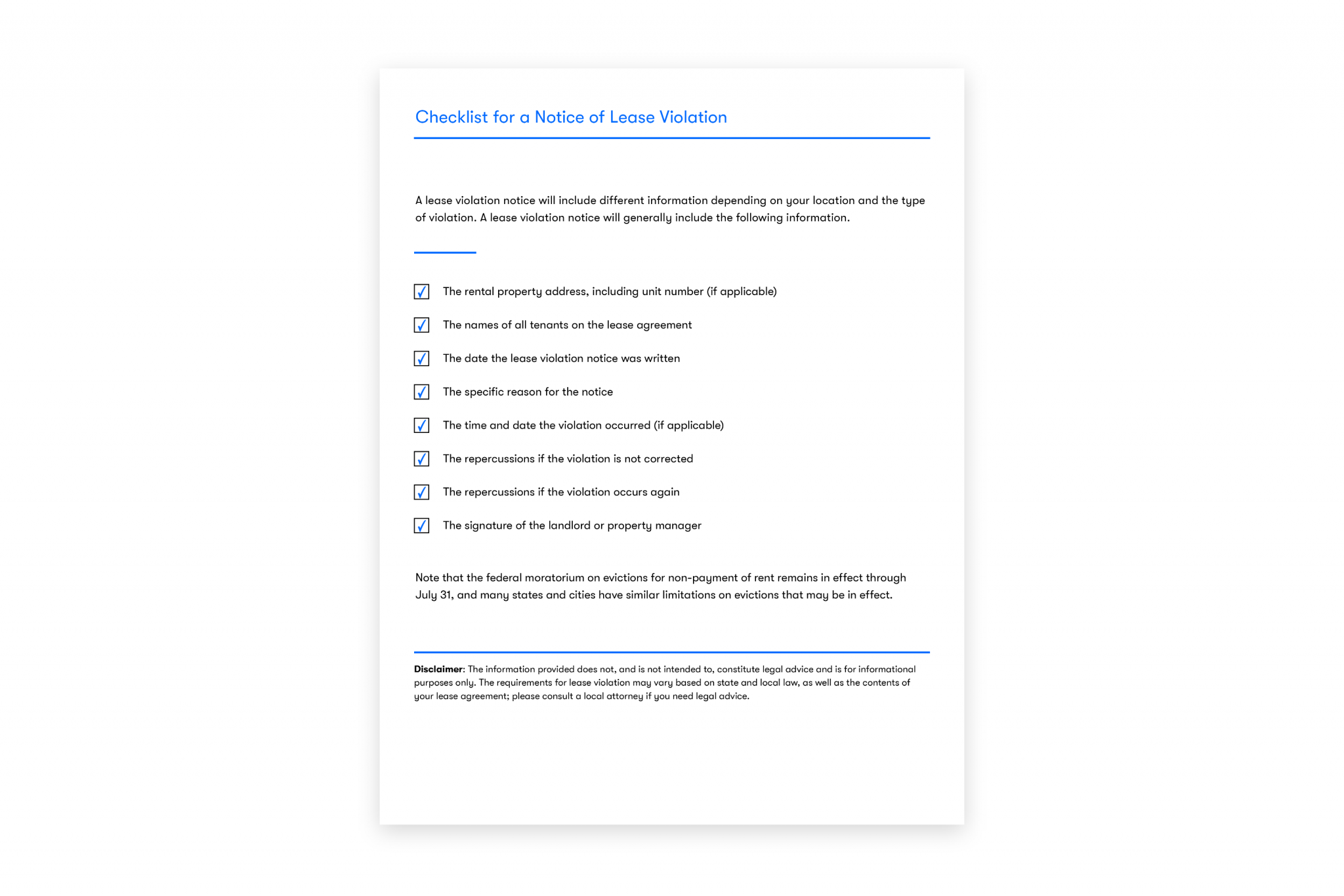Lease Violation Notice to Tenant

January 10, 2020
3 min read
In this article:
- What are common lease violations?
- What should you include in a lease violation notice?
- How do you provide a lease violation notice?
- How long does a tenant have to correct a lease violation?
A lease violation notice, or lease violation letter, explains to the tenant that they are in default of the lease. The tenant is also given a time period to correct the violation. The length of this time period varies by location. Generally, a landlord will provide the tenant with a lease violation notice before a notice to quit.
Note: This guide is for informational purposes only. Zillow, Inc. does not make any guarantees about the sufficiency of the information in or linked to from this guide, or that it’s compliant with current, applicable or local laws. Landlord-tenant laws change rapidly and may be regulated at the federal, state and local levels. This resource is not a substitute for the advice or service of an attorney; you should not rely on this resource for any purpose without consulting with a licensed attorney in your jurisdiction.
What are common lease violations?
When you create a lease, you'll be able to specify conditions that your tenant must uphold — as well as your responsibilities as a landlord. If you encounter a lease violation, keep in mind that a tenant may not be aware that they've violated the lease, or there may be circumstances outside of their control. Make sure to document all violations so they are clear to the tenant when you send a lease violation notice.
Some common types of lease violations are:
- The tenant receives multiple disturbance complaints.
- The tenant has not complied with the pet policy (note that assistance animals are not considered pets).
- The tenant has not properly maintained the rental to be clean and livable.
- There are additional unauthorized occupants living in the rental who aren't on the lease.
- The tenant is using the property for illegal purposes.
- The tenant is overdue on paying rent.
With Zillow Rental Manager, you can create online lease agreements in select locations using customizable lease templates. You'll be able to add your specific rent due dates, pet policies and more.
What should you include in a lease violation notice?
A lease violation notice will include different content depending on your location and the type of violation. In general, a lease violation notice will include:
- The rental property address, including unit number (if applicable)
- The names of all tenants on the lease agreement
- The date the lease violation notice was written
- The specific reason for the notice
- The time and date the violation occurred (if applicable)
- The repercussions if the violation is not corrected
- The repercussions if the violation occurs again
- The signature of the landlord or property manager

How do you provide a lease violation notice?
Communities may have different rules about what lease violation notice delivery methods are acceptable. Here are some ways that a landlord might deliver a lease violation notice:
- Sending the notice via certified mail
- Posting the notice on the door
- Personally delivering the notice to the tenant
Generally, a lease violation notice can be delivered in person or sent via certified mail. Be sure to check with a local attorney about landlord-tenant laws that may govern these notices. In addition, many lease agreements also outline how and when a lease violation notice should be sent.
How long does a tenant have to correct a lease violation?
The number of days a tenant has to fix the issue should be addressed in the lease and can vary by community. Some lease violations require as few as three days for correction, while others allow the tenant up to 30 days. If the tenant fails to correct the lease violation after the allotted time period, the landlord may send the tenant a notice to quit or may have the right to begin the eviction process. Check your local laws and consult an attorney before taking any of these next steps.
For more articles, tips and trends about being a landlord and managing properties, visit our Rentals Resource Center.
Connect with us!
Learn how Zillow Rentals can help you reach your goals.
Stay informed. Stay ahead.
Access exclusive industry insights, market trends, and expert tips. Subscribe now to receive quarterly Zillow Rentals newsletters!